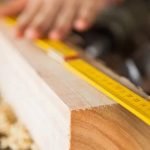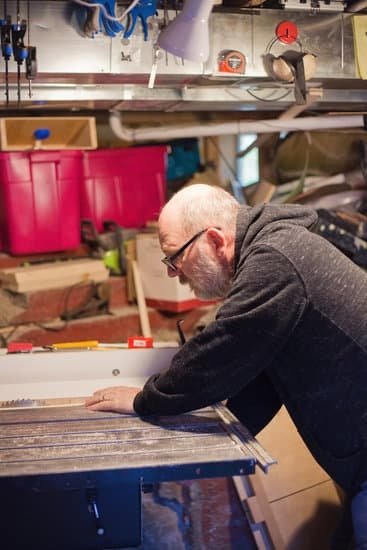Woodworking requires proper preparation of wood, and drying is a crucial step in the process. Understanding how to dry out wood for woodworking is essential for ensuring the success of your projects. Whether you are a beginner or an experienced woodworker, knowing the different methods and techniques for drying wood will greatly impact the quality and longevity of your finished products.
The moisture content of wood significantly affects its workability, stability, and strength. Drying wood effectively reduces the risk of warping, shrinking, or cracking in your woodworking projects. In this article, we will explore the importance of drying wood for woodworking and provide valuable insights into the different methods of accomplishing this.
We will delve into the differences between air drying and kiln drying, offering a step-by-step guide on air drying wood along with tips for effective kiln drying. Additionally, we will discuss methods for testing the dryness of wood to ensure it is ready for use in woodworking projects. By understanding these concepts, you can make informed decisions when choosing the right drying method for your specific woodworking needs.
Different Methods for Drying Wood
When it comes to preparing wood for woodworking projects, one of the most crucial steps is ensuring that the wood is properly dried. There are two main methods for drying wood: air drying and kiln drying. Each method has its own set of advantages and disadvantages, and choosing the right method will depend on factors such as time, budget, and the specific needs of your woodworking project.
Air drying is a traditional method of drying wood that involves simply stacking the lumber in a well-ventilated area and allowing it to dry naturally over time. This process typically takes much longer than kiln drying, often taking several months to a year depending on the type and thickness of the wood. However, air drying is a cost-effective option that requires minimal equipment, making it an attractive choice for hobbyist woodworkers or those with limited resources.
On the other hand, kiln drying offers a faster and more controlled approach to removing moisture from wood. This method involves placing the wood in a specially designed kiln where temperature, humidity, and airflow can be carefully regulated to speed up the drying process. While kiln drying may require an initial investment in equipment and energy costs, it is often preferred for commercial woodworking operations due to its efficiency and predictability.
No matter which method you choose, understanding the differences between air drying and kiln drying is essential for achieving optimal results in your woodworking projects. Whether you opt for the simplicity of air drying or the precision of kiln drying, knowing how to dry out wood for woodworking will ensure that your materials are ready for use in any project you undertake.
The Basics of Air Drying Wood
Air drying wood is a simple and cost-effective method for reducing the moisture content of lumber, making it suitable for woodworking projects. Here’s a step-by-step guide on how to air dry wood effectively:
1. Selecting the Right Location: Choose a well-ventilated, shaded area for air drying your wood. Make sure the location is protected from direct sunlight and harsh weather conditions.
2. Stacking the Wood: Arrange the wood in a way that allows for maximum airflow between each piece. Use stickers or thin strips of wood between each layer to promote air circulation.
3. Monitoring Moisture Levels: Regularly check the moisture content of the wood using a moisture meter. This will help you determine when the wood has reached an acceptable level of dryness for woodworking.
4. Patience is Key: Air drying wood takes time and patience. Depending on the species of wood and environmental conditions, it can take several months to a year for the lumber to reach an optimal moisture content.
5. Protecting the Wood: While air drying, make sure to protect the wood from pests and mold by keeping it off the ground and covering it with a breathable material such as tarpaulin.
6. Final Testing: Once you believe your lumber has reached an acceptable moisture level, perform a final test using a moisture meter or by weighing samples before and after drying.
By following these steps, you can effectively air dry your wood for woodworking projects without having to invest in expensive kiln drying equipment.
Ultimately, learning how to dry out wood for woodworking is an essential skill for any woodworker. Whether you choose to air dry or kiln dry your lumber, understanding the process and patiently following best practices will result in high-quality materials for your woodworking projects.
Pros and Cons of Air Drying Wood for Woodworking Projects
Air drying wood for woodworking projects has been a traditional method used for centuries. This method involves stacking and storing the wood in an open-air environment to allow it to naturally dry out.
One of the main advantages of air drying wood is that it is a cost-effective method, as it does not require expensive equipment like kiln drying does. Additionally, air dried wood tends to have a more natural look and feel compared to kiln dried wood, which can be appealing for certain woodworking projects.
However, air drying wood also has its drawbacks. The process can be significantly slower compared to kiln drying, often taking several months or even years depending on the type of wood and its thickness. During this time, there is also a higher risk of the wood developing defects such as warping, cracking, and insect infestation. The environmental conditions during air drying also need to be carefully monitored to prevent moisture-related issues.
Another disadvantage of air drying wood is that it may not achieve the same level of uniform moisture content as kiln dried wood. This can make the wood more prone to movement and uneven drying when used in woodworking projects. Additionally, due to the longer drying times required for air drying, there may be limitations on the availability of certain types of wood for immediate use in projects.
Overall, while air drying wood for woodworking projects has its benefits such as cost-effectiveness and natural appearance, it also has some limitations in terms of time required and potential risks associated with uneven drying and defects. Nevertheless, understanding these pros and cons can help woodworking enthusiasts make informed decisions about which method best suits their specific project needs.
When considering how to dry out wood for woodworking purposes one must weigh up various factors in order to achieve optimum results from their chosen technique.
The Process of Kiln Drying Wood
Kiln drying is a popular method of preparing wood for woodworking projects. It involves using a kiln, which is essentially a large oven, to remove moisture from the wood in a controlled environment. This process helps to speed up the drying time and produces more stable and uniform results compared to air drying. Kiln drying also has the benefit of killing any insects or fungi present in the wood, making it more suitable for indoor use.
To begin the process of kiln drying wood, you will first need to prepare your lumber by stacking it properly in the kiln. It’s important to arrange the wood so that there is sufficient airflow on all sides to ensure even drying. You’ll also want to make sure that there are minimal gaps between each piece of lumber to prevent unequal drying rates.
Once your wood is properly stacked in the kiln, you can then set the temperature and humidity levels according to the type and thickness of the wood. Different species and sizes of lumber require different drying schedules, so it’s essential to follow guidelines or consult with an expert. Typically, the temperature will be gradually increased over time while controlling humidity levels until the desired moisture content is achieved.
One important thing to note about kiln-dried wood is that it tends to be more expensive than air-dried wood due to the energy costs associated with running a kiln. However, many woodworkers find that the benefits of faster and more controlled drying outweigh this added cost. Overall, understanding how to dry out wood for woodworking using a kiln can greatly benefit your woodworking projects by providing you with stable, high-quality lumber for your creations.
| Kiln Drying Process | What You Need to Know |
|---|---|
| Controlled Environment | Kilns provide a controlled environment for removing moisture from wood. |
| Preparation | Properly stack lumber in kiln ensuring sufficient airflow on all sides. |
| Temperature and Humidity | Set appropriate levels depending on type and thickness of wood, adjust over time until desired moisture content is achieved. |
Tips for Effective Kiln Drying for Woodworking
Kiln drying is an efficient method for drying wood that is often used by woodworking professionals. This process involves placing the wood in a kiln, which is a type of oven or furnace specifically designed to control temperature, humidity, and air circulation to dry the wood evenly and thoroughly.
One of the key factors to consider when it comes to effective kiln drying for woodworking is the control of temperature and humidity levels. It’s crucial to follow a specific drying schedule that gradually increases the temperature and adjusts the humidity over time to prevent warping, cracking, or other forms of damage to the wood. Additionally, proper air circulation within the kiln is essential for ensuring that all parts of the wood dry uniformly.
Woodworkers should also pay close attention to the moisture content of the wood during kiln drying. The goal is to achieve an ideal moisture content level that makes the wood stable and suitable for use in woodworking projects. This typically ranges between 6% to 8% moisture content for most indoor furniture and cabinetry projects.
| Aspect | Details |
|---|---|
| Temperature Control | Gradually increase temperature following a specific schedule |
| Air Circulation | Ensure proper air circulation inside the kiln for uniform drying |
| Moisture Content | Aim for a moisture content level between 6% to 8% |
How to Test if Wood Is Dry Enough for Woodworking
Once you have chosen a method to dry out your wood for woodworking, it’s important to ensure that the wood is dry enough before using it for your projects. Testing the moisture content of the wood is crucial to prevent any issues with warping, cracking, or other damage that can occur if the wood is not properly dried. Here are some methods for testing if wood is dry enough for woodworking.
Moisture Meter
Using a moisture meter is one of the most accurate ways to test the moisture content of wood. This handy tool can provide you with an instant reading of the percentage of moisture in the wood, allowing you to determine if it is at an appropriate level for woodworking. Simply insert the pins of the moisture meter into the wood and wait for the reading.
Weighing Method
Another method for testing if wood is dry enough for woodworking is by using the weighing method. This involves weighing a small sample of the wood and then drying it in an oven until all moisture has been removed. By comparing the weight of the original sample to the weight after drying, you can calculate the percentage of moisture in the wood.
Visual Inspection
In addition to using tools like a moisture meter or weighing method, a visual inspection can also help determine if wood is dry enough for woodworking. Look for signs such as checking, warping, or splitting, which may indicate that the wood still contains too much moisture. It’s important to remember that even if a piece of lumber looks dry on the surface, it may still be retaining moisture deeper within its fibers.
By employing these methods and techniques, you can effectively test if your wood is dry enough for your woodworking projects. Taking this step ensures that your finished pieces will be strong, durable, and free from any unwanted defects caused by excessive moisture content.
Common Mistakes to Avoid When Drying Wood for Woodworking
When it comes to woodworking, one of the key steps is properly drying out the wood before using it in any projects. This ensures that the wood is stable and won’t warp or crack once it’s been fashioned into a finished product. However, there are some common mistakes that woodworkers should be aware of when drying out their wood.
Avoiding Incorrect Stacking Techniques
One common mistake that woodworkers make when air drying their wood is improper stacking techniques. When wood is stacked incorrectly, it can lead to uneven drying and potentially cause warping or cracking. To avoid this, it’s important to stack the lumber with even spacing between each piece to allow for proper air circulation.
Skipping the Initial Moisture Check
Another mistake to avoid is skipping the initial moisture check before beginning the drying process. It’s crucial to know the initial moisture content of the wood in order to determine how long it will take to dry. Skipping this step could lead to under-drying or over-drying, both of which can have negative effects on the quality of the wood.
Not Allowing Sufficient Drying Time
One more common mistake is not allowing sufficient drying time for the wood. Rushing this process can result in unbalanced moisture levels within the lumber, leading to issues down the line when working with it. It’s important to be patient and allow the wood to fully dry out before moving on to any woodworking projects.
By being mindful of these common mistakes and taking care to properly dry out your wood using either air drying or kiln drying methods, you can ensure that your woodworking projects will turn out beautifully and stand up well over time.
Conclusion
In conclusion, the process of drying wood for woodworking is crucial to ensure the success and longevity of your projects. Whether you opt for air drying or kiln drying, it is essential to consider the specific needs of your wood and the requirements of your project. Understanding the different methods and their respective pros and cons will enable you to make an informed decision when choosing the right drying method for your woodworking projects.
When considering how to dry out wood for woodworking, it is important to note that air drying is a cost-effective method that takes longer but can produce high-quality results. On the other hand, kiln drying offers a quicker turnaround time and more precise control over the moisture content, although it may come with higher initial investment costs.
Ultimately, testing the moisture content of the wood and being aware of common mistakes to avoid during the drying process are crucial steps in ensuring that your wood is adequately dried for woodworking. By taking into account all these factors, you can confidently select the most suitable method for drying wood for your specific woodworking projects. By choosing wisely, you can set yourself up for success in creating beautiful and durable pieces that will stand the test of time.
Frequently Asked Questions
How Long Does It Take for Wood to Dry for Woodworking?
The time it takes for wood to dry for woodworking can vary depending on factors such as the type of wood, its initial moisture content, and the drying method used. In general, air-drying wood can take several months to a year for it to reach an acceptable moisture level for woodworking.
Kiln-drying, on the other hand, can significantly reduce the drying time to a matter of weeks.
What Is the Fastest Way to Dry Wood for Woodworking?
The fastest way to dry wood for woodworking is generally through the use of a kiln. Kiln-drying involves placing the wood in a controlled environment with carefully monitored temperature and humidity levels to expedite the drying process.
While this method may require special equipment and expertise, it is an effective way to quickly dry wood while minimizing the risk of warping or cracking.
How Do You Know if Wood Is Dry Enough for Woodworking?
To determine if wood is dry enough for woodworking, it’s important to check its moisture content using a moisture meter. Ideally, wood should have a moisture content between 6-8% for indoor woodworking projects.
Additionally, you can also tap or knock on the wood to listen for a clear, crisp sound which indicates that the wood is sufficiently dry. It’s essential to ensure that the wood is properly dried before using it in any woodworking project to prevent issues such as warping or splitting down the line.

Hi everyone! I’m a woodworker and blogger, and this is my woodworking blog. In my blog, I share tips and tricks for woodworkers of all skill levels, as well as project ideas that you can try yourself.





